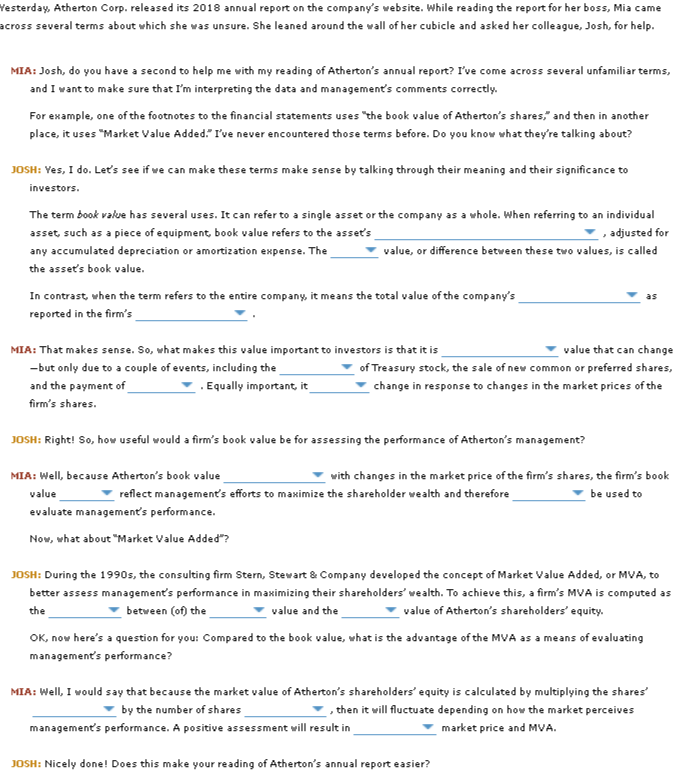
Yesterday, Atherton Corp. released its 2018 annual report on the company's website. While reading the report for her boss, Mia came across several terms about which she was unsure. She leaned around the wall of her cubicle and asked her colleague, Josh, for help. MIA: Josh, do you have a second to help me with my reading of Atherton's annual report? I've come across several unfamiliar terms, and I want to make sure that I'm interpreting the data and management's comments correctly. For example, one of the footnotes to the financial statements uses "the book value of Atherton's shares:" and then in another place, it uses "Market Value Added." I've never encountered those terms before. Do you know what they're talking about? JOSH: Yes, I do. Let's see if we can make these terms make sense by talking through their meaning and their significance to investors. The term book value has several uses. It can refer to a single asset or the company as a whole. When referring to an individual asset, such as a piece of equipment, book value refers to the asset's adjusted for any accumulated depreciation or amortization expense. The value, or difference between these two values, is called the asset's book value. In contrast, when the term refers to the entire company, it means the total value of the company's reported in the firm's as MIA: That makes sense. So, what makes this value important to investors is that it is value that can change - but only due to a couple of events, including the of Treasury stock, the sale of new common or preferred shares, and the payment of .Equally important, it change in response to changes in the market prices of the firm's shares. JOSH: Right! So, how useful would a firm's book value be for assessing the performance of Atherton's management? MIA: Well, because Atherton's book value with changes in the market price of the firm's shares, the firm's book value reflect management's efforts to maximize the shareholder wealth and therefore be used to evaluate management's performance. Now, what about "Market Value Added"? JOSH: During the 1990s, the consulting firm Stern, Stewart & Company developed the concept of Market Value Added, or MVA, to better assess management's performance in maximizing their shareholders' wealth. To achieve this, a firm's MVA is computed as the between (of) the value and the value of Atherton's shareholders' equity. OK, now here's a question for you: Compared to the book value, what is the advantage of the MVA as a means of evaluating management's performance? MIA: Well, I would say that because the market value of Atherton's shareholders' equity is calculated by multiplying the shares' by the number of shares then it will fluctuate depending on how the market perceives management's performance. A positive assessment will result in market price and MVA. JOSH: Nicely done! Does this make your reading of Atherton's annual report easier? Yesterday, Atherton Corp. released its 2018 annual report on the company's website. While reading the report for her boss, Mia came across several terms about which she was unsure. She leaned around the wall of her cubicle and asked her colleague, Josh, for help. MIA: Josh, do you have a second to help me with my reading of Atherton's annual report? I've come across several unfamiliar terms, and I want to make sure that I'm interpreting the data and management's comments correctly. For example, one of the footnotes to the financial statements uses "the book value of Atherton's shares:" and then in another place, it uses "Market Value Added." I've never encountered those terms before. Do you know what they're talking about? JOSH: Yes, I do. Let's see if we can make these terms make sense by talking through their meaning and their significance to investors. The term book value has several uses. It can refer to a single asset or the company as a whole. When referring to an individual asset, such as a piece of equipment, book value refers to the asset's adjusted for any accumulated depreciation or amortization expense. The value, or difference between these two values, is called the asset's book value. In contrast, when the term refers to the entire company, it means the total value of the company's reported in the firm's as MIA: That makes sense. So, what makes this value important to investors is that it is value that can change - but only due to a couple of events, including the of Treasury stock, the sale of new common or preferred shares, and the payment of .Equally important, it change in response to changes in the market prices of the firm's shares. JOSH: Right! So, how useful would a firm's book value be for assessing the performance of Atherton's management? MIA: Well, because Atherton's book value with changes in the market price of the firm's shares, the firm's book value reflect management's efforts to maximize the shareholder wealth and therefore be used to evaluate management's performance. Now, what about "Market Value Added"? JOSH: During the 1990s, the consulting firm Stern, Stewart & Company developed the concept of Market Value Added, or MVA, to better assess management's performance in maximizing their shareholders' wealth. To achieve this, a firm's MVA is computed as the between (of) the value and the value of Atherton's shareholders' equity. OK, now here's a question for you: Compared to the book value, what is the advantage of the MVA as a means of evaluating management's performance? MIA: Well, I would say that because the market value of Atherton's shareholders' equity is calculated by multiplying the shares' by the number of shares then it will fluctuate depending on how the market perceives management's performance. A positive assessment will result in market price and MVA. JOSH: Nicely done! Does this make your reading of Atherton's annual report easier







